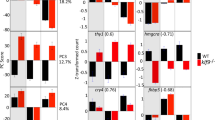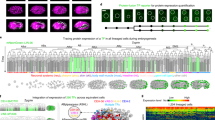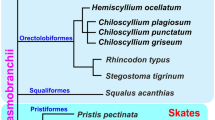Abstract
Fibroblast growth factors (FGFs) are members of a family of some 30 secreted proteins important in the regulation of cellular proliferation, migration, differentiation and survival1,2,3,4. Here we report the identification of a novel modulator of FGF signal transduction, sef, isolated from a zebrafish embryo library through an in situ hybridization screen. The sef gene encodes a transmembrane protein, and belongs to the synexpression group that includes some of the fgf genes. Sef expression is positively regulated by FGF, and ectopic expression of sef in zebrafish or Xenopus laevis embryos specifically inhibits FGF signalling. In co-immunoprecipitation assays, the intracellular domain of Sef interacts with FGF receptors, FGFR1 and FGFR2. Injection of antisense sef morpholino oligos mimicked the phenotypes observed by ectopic fgf8 expression, suggesting that Sef is required to limit FGF signalling during development.
This is a preview of subscription content, access via your institution
Access options
Subscribe to this journal
Receive 12 print issues and online access
$209.00 per year
only $17.42 per issue
Buy this article
- Purchase on Springer Link
- Instant access to full article PDF
Prices may be subject to local taxes which are calculated during checkout




Similar content being viewed by others
References
Niswander, L., Tickle, C., Vogel, A., Booth, I. & Martin, G. R. Cell 75, 579–587 (1993).
Trumpp, A., Depew, M. J., Rubenstein, J. L., Bishop, J. M. & Martin, G. R. Genes Dev. 13, 3136–3148 (1999).
Sun, X., Meyers, E. N., Lewandoski, M. & Martin, G. R. Genes Dev. 13, 1834–1846 (1999).
Friesel, R. & Maciag, T. Thromb. Haemost. 82, 748–754 (1999).
Furthauer, M., Thisse, C. & Thisse, B. Development 124, 4253–4264 (1997).
Reifers, F., Adams, J., Mason, I. J., Schulte-Merker, S. & Brand, M. Mech. Dev. 99, 39–49 (2000).
Reifers, F. et al. Development 125, 2381–2395 (1998).
Lun, K. & Brand, M. Development 125, 3049–3062 (1998).
Macdonald, R. et al. Development 124, 2397–408 (1997).
Joyner, A. L., Liu, A. & Millet, S. Curr. Opin. Cell Biol. 12, 736–741 (2000).
Onichtchouk, D. et al. Nature 401, 480–5 (1999).
Tsang, M. et al. Genesis 28, 47–57 (2000).
Kudoh, T. et al. Genome Res. 11, 1979–1987 (2001).
Gawantka, V. et al. Mech. Dev. 77, 95–141 (1998).
Griffin, K., Patient, R. & Holder, N. Development 121, 2983–2994 (1995).
Amaya, E., Stein, P. A., Musci, T. J. & Kirschner, M. W. Development 118, 477–487 (1993).
Green, J. B., New, H. V. & Smith, J. C. Cell 71, 731–739 (1992).
Nasevicius, A. & Ekker, S. C. Nature Genet. 26, 216–220. (2000).
Friesel, R. & Brown, S. A. Development 116, 1051–1058 (1992).
Friesel, R. & Dawid, I. B. Mol. Cell Biol. 11, 2481–2488 (1991).
Ghiglione, C. et al. Cell 96, 847–56 (1999).
Reich, A., Sapir, A. & Shilo, B. Development 126, 4139–4147 (1999).
Hacohen, N., Kramer, S., Sutherland, D., Hiromi, Y. & Krasnow, M. A. Cell 92, 253–263 (1998).
Casci, T., Vinos, J. & Freeman, M. Cell 96, 655–665 (1999).
Fürthauer, M., Lin, W., Ang, S., Thisse, B. & Thisse, C. Nature Cell Biol. D.O.I. 10.1038/ncb750 (2002).
Isaacs, H. V., Pownall, M. E. & Slack, J. M. EMBO J. 13, 4469–4481 (1994).
Martinez, S., Crossley, P. H., Cobos, I., Rubenstein, J. L. & Martin, G. R. Development 126, 1189–1200 (1999).
Weinstein, D. C., Marden, J., Carnevali, F. & Hemmati-Brivanlou, A. Nature 394, 904–908 (1998).
Neilson, K. M. & Friesel, R. J. Biol. Chem. 271, 25049–25057 (1996).
Acknowledgements
We are grateful to E. Weinberg, D. Stainier, and M. Halpern for zebrafish lines; M. Whitman, J. Breen, M. Ekker, E. M. De Robertis and A. B. Roberts for constructs; and E. Laver for zebrafish technical assistance. N. Hukriede, A. Kawahara, L. Kodjabachian and I. Daar for discussions and critical reading of the manuscript. We thank B. Thisse and C. Thisse for sharing unpublished results. R.F. was supported by grants DE13248, HL65301 and RR15555 from the NIH.
Author information
Authors and Affiliations
Corresponding author
Supplementary information
Supplementary Figures
Figure S1 Sef sequence analysis. (PDF 432 kb)
Figure S2 Ectopic expression of sef in Zebrafish and Xenopus embryos.
Rights and permissions
About this article
Cite this article
Tsang, M., Friesel, R., Kudoh, T. et al. Identification of Sef, a novel modulator of FGF signalling. Nat Cell Biol 4, 165–169 (2002). https://doi.org/10.1038/ncb749
Received:
Revised:
Accepted:
Published:
Issue Date:
DOI: https://doi.org/10.1038/ncb749
This article is cited by
-
Transferrin receptor 1 promotes the fibroblast growth factor receptor-mediated oncogenic potential of diffused-type gastric cancer
Oncogene (2022)
-
Interleukin-17 receptor D (Sef) is a multi-functional regulator of cell signaling
Cell Communication and Signaling (2021)
-
Loss of interleukin-17 receptor D promotes chronic inflammation-associated tumorigenesis
Oncogene (2021)
-
A shedding soluble form of interleukin-17 receptor D exacerbates collagen-induced arthritis through facilitating TNF-α-dependent receptor clustering
Cellular & Molecular Immunology (2021)
-
Combined whole-mount fluorescence in situ hybridization and antibody staining in zebrafish embryos and larvae
Nature Protocols (2020)



